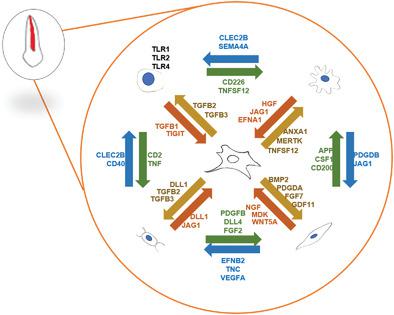当前位置:
X-MOL 学术
›
Small Methods
›
论文详情
Our official English website, www.x-mol.net, welcomes your feedback! (Note: you will need to create a separate account there.)
Landscape of Cell Communication in Human Dental Pulp
Small Methods ( IF 12.4 ) Pub Date : 2021-08-16 , DOI: 10.1002/smtd.202100747 Wei Yin 1 , Gaoxia Liu 2, 3 , Jinhong Li 4 , Zhuan Bian 1
Small Methods ( IF 12.4 ) Pub Date : 2021-08-16 , DOI: 10.1002/smtd.202100747 Wei Yin 1 , Gaoxia Liu 2, 3 , Jinhong Li 4 , Zhuan Bian 1
Affiliation

|
The cellular atlas of the stroma is not well understood. Here, the cell populations in human dental pulp through single-cell RNA sequencing are profiled. Dental pulp stem cells, pulp cells, T cells, macrophages, endothelial cells, and glial cells are identified in human dental pulp. These cells support each other through sending growth signals. Based on the appearance of ligand–receptor pairs between two cell populations, pulp cells have the greatest communication with other cell types, while T cells have the least communication. In addition, T cells expressing TLR1, TLR2, and TLR4, and endothelial cells expressing TLR4, monitor bacterial invasion. These findings provide the census of normal dental pulp.
中文翻译:

人类牙髓中细胞通讯的前景
基质的细胞图谱尚不清楚。在这里,通过单细胞 RNA 测序分析了人类牙髓中的细胞群。在人牙髓中鉴定出牙髓干细胞、牙髓细胞、T细胞、巨噬细胞、内皮细胞和神经胶质细胞。这些细胞通过发送生长信号相互支持。根据两个细胞群之间配体-受体对的出现,牙髓细胞与其他细胞类型的交流最多,而 T 细胞的交流最少。此外,表达TLR1、TLR2和TLR4的 T 细胞以及表达TLR4的内皮细胞监测细菌入侵。这些发现提供了正常牙髓的普查。
更新日期:2021-09-14
中文翻译:

人类牙髓中细胞通讯的前景
基质的细胞图谱尚不清楚。在这里,通过单细胞 RNA 测序分析了人类牙髓中的细胞群。在人牙髓中鉴定出牙髓干细胞、牙髓细胞、T细胞、巨噬细胞、内皮细胞和神经胶质细胞。这些细胞通过发送生长信号相互支持。根据两个细胞群之间配体-受体对的出现,牙髓细胞与其他细胞类型的交流最多,而 T 细胞的交流最少。此外,表达TLR1、TLR2和TLR4的 T 细胞以及表达TLR4的内皮细胞监测细菌入侵。这些发现提供了正常牙髓的普查。


























 京公网安备 11010802027423号
京公网安备 11010802027423号